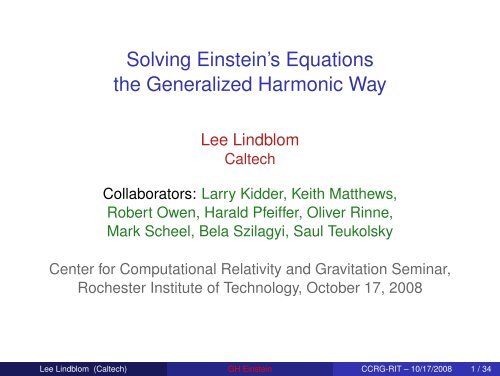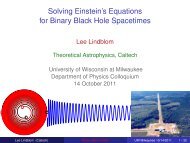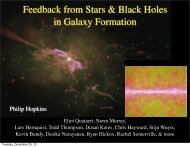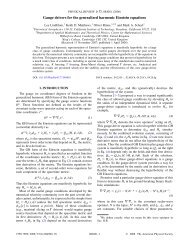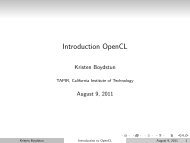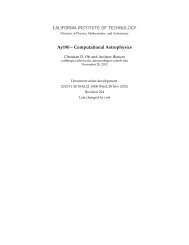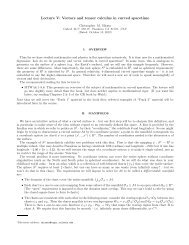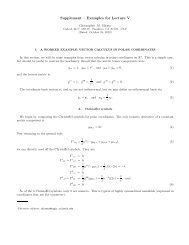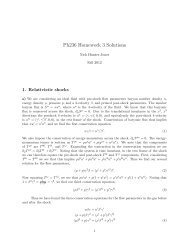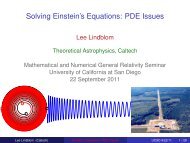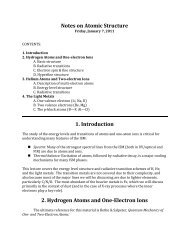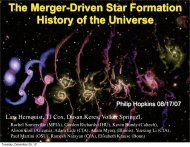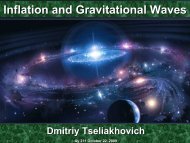Solving Einstein's Equations the Generalized Harmonic Way
Solving Einstein's Equations the Generalized Harmonic Way
Solving Einstein's Equations the Generalized Harmonic Way
Create successful ePaper yourself
Turn your PDF publications into a flip-book with our unique Google optimized e-Paper software.
<strong>Solving</strong> Einstein’s <strong>Equations</strong><br />
<strong>the</strong> <strong>Generalized</strong> <strong>Harmonic</strong> <strong>Way</strong><br />
Lee Lindblom<br />
Caltech<br />
Collaborators: Larry Kidder, Keith Mat<strong>the</strong>ws,<br />
Robert Owen, Harald Pfeiffer, Oliver Rinne,<br />
Mark Scheel, Bela Szilagyi, Saul Teukolsky<br />
Center for Computational Relativity and Gravitation Seminar,<br />
Rochester Institute of Technology, October 17, 2008<br />
Lee Lindblom (Caltech) GH Einstein CCRG-RIT – 10/17/2008 1 / 34
Outline of Talk:<br />
Methods of Specifying Gauge (Coordinates).<br />
<strong>Generalized</strong> <strong>Harmonic</strong> (GH) Einstein <strong>Equations</strong>.<br />
Constraint Damping.<br />
Boundary Conditions.<br />
Constraint Preserving.<br />
Physical.<br />
Moving Black Holes in a Spectral Code.<br />
Dual Coordinate Frame Evolution.<br />
Choosing Coordinates by Feedback Control.<br />
Gauge Drivers in <strong>the</strong> GH Einstein System.<br />
Lee Lindblom (Caltech) GH Einstein CCRG-RIT – 10/17/2008 2 / 34
Traditional ADM Gauge Conditions<br />
Construct a foliation of<br />
spacetime by spatial<br />
slices.<br />
Choose a time function<br />
with t = const. on <strong>the</strong>se<br />
slices.<br />
Choose spatial coordinates,<br />
x k , on each slice.<br />
⃗n = ∂ τ<br />
(t, x k )<br />
Decompose <strong>the</strong> 4-metric ψ ab into its 3+1 parts:<br />
ds 2 = ψ ab dx a dx b = −N 2 dt 2 + g ij (dx i + N i dt)(dx j + N j dt).<br />
The lapse N and shift N i measure how coordinates are laid out on<br />
spacetime: ⃗n = ∂ τ = ∂t<br />
∂τ ∂ t + ∂x k<br />
∂τ ∂ k,<br />
= 1 N ∂ t − Nk<br />
N ∂ k.<br />
Spacetime coordinates are determined in <strong>the</strong> traditional ADM<br />
method by specifying <strong>the</strong> lapse N and shift N i .<br />
∂ k<br />
(t + δt, x k )<br />
Lee Lindblom (Caltech) GH Einstein CCRG-RIT – 10/17/2008 3 / 34<br />
∂ t
ADM Evolution System<br />
When <strong>the</strong> gauge is determined by specifying <strong>the</strong> lapse N and shift<br />
N k , <strong>the</strong> Einstein system becomes a set of evolution equations for<br />
<strong>the</strong> spatial metric g ij and extrinsic curvature K ij :<br />
∂ t g ij − N k ∂ k g ij = −2NK ij + ∇ i N j + ∇ j N i ,<br />
( )<br />
∂ t K ij − N k ∂ k K ij = N (3)<br />
R ij − 2K k i K kj + KK ij<br />
−∇ i ∇ j N + K ik ∂ j N k + K kj ∂ i N k .<br />
The Einstein equations also include constraints:<br />
0 = Mˆt<br />
≡ (3) R − K ij K ij + K 2 ,<br />
0 = M i ≡ ∇ k K ki − ∇ i K .<br />
This traditional form of <strong>the</strong> Einstein equations is not hyperbolic,<br />
and numerical solutions are found to suffer from generic constraint<br />
violating instabilities.<br />
Lee Lindblom (Caltech) GH Einstein CCRG-RIT – 10/17/2008 4 / 34
<strong>Generalized</strong> <strong>Harmonic</strong> Gauge Conditions<br />
An alternate way to specify <strong>the</strong> gauge (i.e. coordinates) in <strong>the</strong><br />
Einstein equations is through <strong>the</strong> gauge source function H a :<br />
Let H a denote <strong>the</strong> function obtained by <strong>the</strong> action of <strong>the</strong> covariant<br />
scalar wave operator on <strong>the</strong> coordinates x a :<br />
H a ≡ ∇ c ∇ c x a = ψ bc (∂ b ∂ c x a − Γ e bc∂ e x a ) = −Γ a ,<br />
where Γ a = ψ bc Γ a bc and ψ ab is <strong>the</strong> 4-metric.<br />
Lee Lindblom (Caltech) GH Einstein CCRG-RIT – 10/17/2008 5 / 34
<strong>Generalized</strong> <strong>Harmonic</strong> Gauge Conditions<br />
An alternate way to specify <strong>the</strong> gauge (i.e. coordinates) in <strong>the</strong><br />
Einstein equations is through <strong>the</strong> gauge source function H a :<br />
Let H a denote <strong>the</strong> function obtained by <strong>the</strong> action of <strong>the</strong> covariant<br />
scalar wave operator on <strong>the</strong> coordinates x a :<br />
H a ≡ ∇ c ∇ c x a = ψ bc (∂ b ∂ c x a − Γ e bc∂ e x a ) = −Γ a ,<br />
where Γ a = ψ bc Γ a bc and ψ ab is <strong>the</strong> 4-metric.<br />
Specifying coordinates by <strong>the</strong> generalized harmonic (GH) method<br />
can be accomplished by choosing a gauge-source function<br />
H a (x, ψ), and requiring that<br />
(√ )<br />
H a (x, ψ) = −Γ a = ∂ b −ψψ<br />
ab<br />
/ √ −ψ.<br />
Lee Lindblom (Caltech) GH Einstein CCRG-RIT – 10/17/2008 5 / 34
Einstein’s Equation with <strong>the</strong> GH Method<br />
The spacetime Ricci tensor can be written as:<br />
R ab = − 1 2 ψcd ∂ c ∂ d ψ ab + ∇ (a Γ b) + F ab (ψ, ∂ψ),<br />
where ψ ab is <strong>the</strong> 4-metric, and Γ a = ψ bc Γ abc .<br />
The <strong>Generalized</strong> <strong>Harmonic</strong> Einstein equation is obtained by<br />
replacing Γ a with −H a (x, ψ) = −ψ ab H b (x, ψ):<br />
R ab − ∇ (a<br />
[<br />
Γb) + H b)<br />
]<br />
= −<br />
1<br />
2 ψcd ∂ c ∂ d ψ ab − ∇ (a H b) + F ab (ψ, ∂ψ).<br />
The vacuum GH Einstein equation, R ab = 0 with Γ a + H a = 0, is<br />
<strong>the</strong>refore manifestly hyperbolic, having <strong>the</strong> same principal part as<br />
<strong>the</strong> scalar wave equation:<br />
0 = ∇ a ∇ a Φ = ψ ab ∂ a ∂ b Φ + F(∂Φ).<br />
Lee Lindblom (Caltech) GH Einstein CCRG-RIT – 10/17/2008 6 / 34
Gauge and Constraints in Electromagnetism<br />
The usual representation of <strong>the</strong> vacuum Maxwell equations split<br />
into evolution equations and constraints:<br />
∂ t<br />
⃗ E = ⃗ ∇ × ⃗ B, ∇ · ⃗ E = 0,<br />
∂ t<br />
⃗ B = − ⃗ ∇ × ⃗ E, ∇ · ⃗ B = 0.<br />
These equations are often written in <strong>the</strong> more compact<br />
4-dimensional notation: ∇ a F ab = 0 and ∇ [a F bc] = 0,<br />
where F ab has components ⃗ E and ⃗ B.<br />
Lee Lindblom (Caltech) GH Einstein CCRG-RIT – 10/17/2008 7 / 34
Gauge and Constraints in Electromagnetism<br />
The usual representation of <strong>the</strong> vacuum Maxwell equations split<br />
into evolution equations and constraints:<br />
∂ t<br />
⃗ E = ⃗ ∇ × ⃗ B, ∇ · ⃗ E = 0,<br />
∂ t<br />
⃗ B = − ⃗ ∇ × ⃗ E, ∇ · ⃗ B = 0.<br />
These equations are often written in <strong>the</strong> more compact<br />
4-dimensional notation: ∇ a F ab = 0 and ∇ [a F bc] = 0,<br />
where F ab has components ⃗ E and ⃗ B.<br />
Maxwell’s equations are often re-expressed in terms of a vector<br />
potential F ab = ∇ a A b − ∇ b A a :<br />
∇ a ∇ a A b − ∇ b ∇ a A a = 0.<br />
Lee Lindblom (Caltech) GH Einstein CCRG-RIT – 10/17/2008 7 / 34
Gauge and Constraints in Electromagnetism<br />
The usual representation of <strong>the</strong> vacuum Maxwell equations split<br />
into evolution equations and constraints:<br />
∂ t<br />
⃗ E = ⃗ ∇ × ⃗ B, ∇ · ⃗ E = 0,<br />
∂ t<br />
⃗ B = − ⃗ ∇ × ⃗ E, ∇ · ⃗ B = 0.<br />
These equations are often written in <strong>the</strong> more compact<br />
4-dimensional notation: ∇ a F ab = 0 and ∇ [a F bc] = 0,<br />
where F ab has components ⃗ E and ⃗ B.<br />
Maxwell’s equations are often re-expressed in terms of a vector<br />
potential F ab = ∇ a A b − ∇ b A a :<br />
∇ a ∇ a A b − ∇ b ∇ a A a = 0.<br />
This form of Maxwell’s equations is manifestly hyperbolic as long<br />
as <strong>the</strong> gauge is chosen correctly, e.g., let ∇ a A a = H(x, t), giving:<br />
∇ a ∇ a A b ≡ ( −∂ 2 t + ∂ 2 x + ∂ 2 y + ∂ 2 z<br />
)<br />
Ab = ∇ b H.<br />
Lee Lindblom (Caltech) GH Einstein CCRG-RIT – 10/17/2008 7 / 34
Constraint Damping<br />
Where are <strong>the</strong> constraints: ∇ a ∇ a A b = ∇ b H?<br />
Lee Lindblom (Caltech) GH Einstein CCRG-RIT – 10/17/2008 8 / 34
Constraint Damping<br />
Where are <strong>the</strong> constraints: ∇ a ∇ a A b = ∇ b H?<br />
Gauge condition becomes a constraint: 0 = C ≡ ∇ a A a − H.<br />
Maxwell’s equations imply that this constraint is preserved:<br />
∇ a ∇ a C = 0.<br />
Lee Lindblom (Caltech) GH Einstein CCRG-RIT – 10/17/2008 8 / 34
Constraint Damping<br />
Where are <strong>the</strong> constraints: ∇ a ∇ a A b = ∇ b H?<br />
Gauge condition becomes a constraint: 0 = C ≡ ∇ a A a − H.<br />
Maxwell’s equations imply that this constraint is preserved:<br />
∇ a ∇ a C = 0.<br />
Modify evolution equations by adding multiples of <strong>the</strong> constraints:<br />
∇ a ∇ a A b = ∇ b H+γ 0 t b C = ∇ b H+γ 0 t b (∇ a A a − H).<br />
These changes also affect <strong>the</strong> constraint evolution equation,<br />
∇ a ∇ a C−γ 0 t b ∇ b C = 0,<br />
so constraint violations are damped when γ 0 > 0.<br />
Lee Lindblom (Caltech) GH Einstein CCRG-RIT – 10/17/2008 8 / 34
<strong>Generalized</strong> <strong>Harmonic</strong> Evolution System<br />
Frans Pretorius wrote a very nice second order finite difference<br />
AMR code to solve <strong>the</strong> generalized harmonic Einstein equations:<br />
0 = R ab − ∇ (a Γ b) − ∇ (a H b) ,<br />
= R ab − ∇ (a C b) ,<br />
where C a = H a + Γ a . Unfortunately initial code was very unstable.<br />
Lee Lindblom (Caltech) GH Einstein CCRG-RIT – 10/17/2008 9 / 34
<strong>Generalized</strong> <strong>Harmonic</strong> Evolution System<br />
Frans Pretorius wrote a very nice second order finite difference<br />
AMR code to solve <strong>the</strong> generalized harmonic Einstein equations:<br />
0 = R ab − ∇ (a Γ b) − ∇ (a H b) ,<br />
= R ab − ∇ (a C b) ,<br />
where C a = H a + Γ a . Unfortunately initial code was very unstable.<br />
Imposing coordinates using a GH gauge function profoundly<br />
changes <strong>the</strong> constraints. The GH constraint, C a = 0, where<br />
C a = H a + Γ a ,<br />
depends only on first derivatives of <strong>the</strong> metric. The standard<br />
Hamiltonian and momentum constraints, M a = 0, are determined<br />
by <strong>the</strong> derivatives of <strong>the</strong> gauge constraint C a :<br />
M a ≡<br />
[<br />
R ab − 1 2 ψ abR<br />
]<br />
n b =<br />
[∇ (a C b) − 1 2 ψ ab∇ c C c<br />
]<br />
n b .<br />
Lee Lindblom (Caltech) GH Einstein CCRG-RIT – 10/17/2008 9 / 34
Constraint Damping <strong>Generalized</strong> <strong>Harmonic</strong> System<br />
Pretorius (based on a suggestion from Gundlach, et al.) modified<br />
<strong>the</strong> GH system by adding terms proportional to <strong>the</strong> gauge<br />
constraints:<br />
[<br />
0 = R ab − ∇ (a C b) + γ 0 n (a C b) − 1 2 ψ ab n c C c<br />
],<br />
where n a is a unit timelike vector field. Since C a = H a + Γ a<br />
depends only on first derivatives of <strong>the</strong> metric, <strong>the</strong>se additional<br />
terms do not change <strong>the</strong> hyperbolic structure of <strong>the</strong> system.<br />
Lee Lindblom (Caltech) GH Einstein CCRG-RIT – 10/17/2008 10 / 34
Constraint Damping <strong>Generalized</strong> <strong>Harmonic</strong> System<br />
Pretorius (based on a suggestion from Gundlach, et al.) modified<br />
<strong>the</strong> GH system by adding terms proportional to <strong>the</strong> gauge<br />
constraints:<br />
[<br />
0 = R ab − ∇ (a C b) + γ 0 n (a C b) − 1 2 ψ ab n c C c<br />
],<br />
where n a is a unit timelike vector field. Since C a = H a + Γ a<br />
depends only on first derivatives of <strong>the</strong> metric, <strong>the</strong>se additional<br />
terms do not change <strong>the</strong> hyperbolic structure of <strong>the</strong> system.<br />
Evolution of <strong>the</strong> constraints C a follow from <strong>the</strong> Bianchi identities:<br />
0 = ∇ c ∇ c C a −2γ 0 ∇ c[ n (c C a)<br />
]<br />
+ C c ∇ (c C a) − 1 2 γ 0 n a C c C c .<br />
This is a damped wave equation for C a , that drives all small<br />
short-wavelength constraint violations toward zero as <strong>the</strong> system<br />
evolves (for γ 0 > 0).<br />
Lee Lindblom (Caltech) GH Einstein CCRG-RIT – 10/17/2008 10 / 34
First-Order Einstein Evolution System<br />
Introduce new fields Π ab and Φ iab representing <strong>the</strong> time and space<br />
derivatives of <strong>the</strong> metric ψ ab .<br />
Our code solves a first-order representation of <strong>the</strong> GH Einstein<br />
evolution system:<br />
∂ t ψ ab = −NΠ ab + N i Φ iab ,<br />
∂ t Π ab − N k ∂ k Π ab + Ng ki ∂ k Φ iab + γ 2 N k ∂ k ψ ab ≃ 0,<br />
∂ t Φ iab − N k ∂ k Φ iab + N∂ i Π ab − γ 2 N∂ i Ψ ab ≃ 0.<br />
Violations of <strong>the</strong> additional constraint, C iab = Φ iab − ∂ i ψ ab , are<br />
suppressed on <strong>the</strong> timescale 1/γ 2 by this evolution system.<br />
This evolution system can be written very abstractly as:<br />
∂ t u α + A k α β(u)∂ k u β = F α (u), where u α = {ψ ab , Π ab , Φ iab }.<br />
This system is symmetric hyperbolic because <strong>the</strong>re exists a<br />
positive definite symmetric S αβ that symmetrizes <strong>the</strong><br />
characteristic matrices: A k αβ = Ak βα = S αγA k γ β.<br />
Lee Lindblom (Caltech) GH Einstein CCRG-RIT – 10/17/2008 11 / 34
Numerical Tests of <strong>the</strong> First-Order GH System<br />
3D numerical evolutions of static black-hole spacetimes illustrate<br />
<strong>the</strong> constraint damping properties of <strong>the</strong> GH evolution system.<br />
These evolutions are stable and convergent when γ 0 = γ 2 = 1.<br />
|| C ||<br />
10 -4<br />
10 -6<br />
10 -2 t/M<br />
γ 0<br />
= γ 2<br />
= 0.0<br />
γ 0<br />
= 1.0,<br />
γ 2<br />
= 0.0<br />
γ 0<br />
= 0.0, γ 2<br />
= 1.0<br />
|| C ||<br />
10 -4<br />
10 -6<br />
10 -2 t/M<br />
{N r<br />
, L max<br />
} = {9, 7}<br />
{11, 7}<br />
10 -8<br />
γ 0<br />
= γ 2<br />
= 1.0<br />
10 -8<br />
{13, 7}<br />
10 -10<br />
0 100 200<br />
10 -10<br />
0 5000 10000<br />
The boundary conditions used for this simple test problem freeze<br />
<strong>the</strong> incoming characteristic fields to <strong>the</strong>ir initial values.<br />
Lee Lindblom (Caltech) GH Einstein CCRG-RIT – 10/17/2008 12 / 34
Outline of Talk:<br />
Methods of Specifying Gauge (Coordinates).<br />
<strong>Generalized</strong> <strong>Harmonic</strong> (GH) Einstein <strong>Equations</strong>.<br />
Constraint Damping.<br />
Boundary Conditions.<br />
Constraint Preserving.<br />
Physical.<br />
Moving Black Holes in a Spectral Code.<br />
Dual Coordinate Frame Evolution.<br />
Choosing Coordinates by Feedback Control.<br />
Gauge Drivers in <strong>the</strong> GH Einstein System.<br />
Lee Lindblom (Caltech) GH Einstein CCRG-RIT – 10/17/2008 13 / 34
Boundary Conditions<br />
Boundary conditions are straightforward to formulate for first-order<br />
hyperbolic evolutions systems,<br />
∂ t u α + A k α β(u)∂ k u β = F α (u).<br />
For <strong>the</strong> GH system u α = {ψ ab , Π ab , Φ kab }.<br />
Lee Lindblom (Caltech) GH Einstein CCRG-RIT – 10/17/2008 14 / 34
Boundary Conditions<br />
Boundary conditions are straightforward to formulate for first-order<br />
hyperbolic evolutions systems,<br />
∂ t u α + A k α β(u)∂ k u β = F α (u).<br />
For <strong>the</strong> GH system u α = {ψ ab , Π ab , Φ kab }.<br />
Find <strong>the</strong> eigenvectors of <strong>the</strong> characteristic matrix s k A k α β at each<br />
boundary point:<br />
e ˆα α s k A k α β = v (ˆα) e ˆα β,<br />
where s k is <strong>the</strong> outward directed unit normal to <strong>the</strong> boundary.<br />
Lee Lindblom (Caltech) GH Einstein CCRG-RIT – 10/17/2008 14 / 34
Boundary Conditions<br />
Boundary conditions are straightforward to formulate for first-order<br />
hyperbolic evolutions systems,<br />
∂ t u α + A k α β(u)∂ k u β = F α (u).<br />
For <strong>the</strong> GH system u α = {ψ ab , Π ab , Φ kab }.<br />
Find <strong>the</strong> eigenvectors of <strong>the</strong> characteristic matrix s k A k α β at each<br />
boundary point:<br />
e ˆα α s k A k α β = v (ˆα) e ˆα β,<br />
where s k is <strong>the</strong> outward directed unit normal to <strong>the</strong> boundary.<br />
For hyperbolic evolution systems <strong>the</strong> eigenvectors e ˆα α are<br />
complete: det e ˆα α ≠ 0. So we define <strong>the</strong> characteristic fields:<br />
u ˆα = e ˆα αu α .<br />
Lee Lindblom (Caltech) GH Einstein CCRG-RIT – 10/17/2008 14 / 34
Boundary Conditions<br />
Boundary conditions are straightforward to formulate for first-order<br />
hyperbolic evolutions systems,<br />
∂ t u α + A k α β(u)∂ k u β = F α (u).<br />
For <strong>the</strong> GH system u α = {ψ ab , Π ab , Φ kab }.<br />
Find <strong>the</strong> eigenvectors of <strong>the</strong> characteristic matrix s k A k α β at each<br />
boundary point:<br />
e ˆα α s k A k α β = v (ˆα) e ˆα β,<br />
where s k is <strong>the</strong> outward directed unit normal to <strong>the</strong> boundary.<br />
For hyperbolic evolution systems <strong>the</strong> eigenvectors e ˆα α are<br />
complete: det e ˆα α ≠ 0. So we define <strong>the</strong> characteristic fields:<br />
u ˆα = e ˆα αu α .<br />
A boundary condition must be imposed on each incoming<br />
characteristic field (i.e. every field with v (ˆα) < 0), and must not be<br />
imposed on any outgoing field (i.e. any field with v (ˆα) > 0).<br />
Lee Lindblom (Caltech) GH Einstein CCRG-RIT – 10/17/2008 14 / 34
Evolutions of a Perturbed Schwarzschild Black Hole<br />
A black-hole spacetime is<br />
perturbed by an incoming<br />
gravitational wave that excites<br />
quasi-normal oscillations.<br />
Use boundary conditions that<br />
Freeze <strong>the</strong> remaining<br />
incoming characteristic fields.<br />
{N r<br />
, L } =<br />
{11, 9}<br />
10 -6<br />
|| C ||<br />
{13, 11}<br />
10 -10<br />
{17, 15}<br />
{21, 19}<br />
10 -14<br />
0 50 100<br />
10 -2 max<br />
t/M<br />
The resulting outgoing waves<br />
interact with <strong>the</strong> boundary of<br />
<strong>the</strong> computational domain and<br />
produce constraint violations.<br />
Lapse Movie<br />
Constraint Movie<br />
Lee Lindblom (Caltech) GH Einstein CCRG-RIT – 10/17/2008 15 / 34
Constraint Evolution for <strong>the</strong> First-Order GH System<br />
The evolution of <strong>the</strong> constraints,<br />
c A = {C a , C kab , M a ≈ n c ∂ c C a , C ka ≈ ∂ k C a , C klab = ∂ [k Φ l]ab } are<br />
determined by <strong>the</strong> evolution of <strong>the</strong> fields u α = {ψ ab , Π ab , Φ kab }:<br />
∂ t c A + A k A B(u)∂ k c B = F A B(u, ∂u) c B .<br />
Lee Lindblom (Caltech) GH Einstein CCRG-RIT – 10/17/2008 16 / 34
Constraint Evolution for <strong>the</strong> First-Order GH System<br />
The evolution of <strong>the</strong> constraints,<br />
c A = {C a , C kab , M a ≈ n c ∂ c C a , C ka ≈ ∂ k C a , C klab = ∂ [k Φ l]ab } are<br />
determined by <strong>the</strong> evolution of <strong>the</strong> fields u α = {ψ ab , Π ab , Φ kab }:<br />
∂ t c A + A k A B(u)∂ k c B = F A B(u, ∂u) c B .<br />
This constraint evolution system is symmetric hyperbolic with<br />
principal part:<br />
∂ t C a ≃ 0,<br />
∂ t M a − N k ∂ k M a − Ng ij ∂ i C ja ≃ 0,<br />
∂ t C ia − N k ∂ k C ia − N∂ i M a ≃ 0,<br />
∂ t C iab − (1 + γ 1 )N k ∂ k C iab ≃ 0,<br />
∂ t C ijab − N k ∂ k C ijab ≃ 0.<br />
Lee Lindblom (Caltech) GH Einstein CCRG-RIT – 10/17/2008 16 / 34
Constraint Evolution for <strong>the</strong> First-Order GH System<br />
The evolution of <strong>the</strong> constraints,<br />
c A = {C a , C kab , M a ≈ n c ∂ c C a , C ka ≈ ∂ k C a , C klab = ∂ [k Φ l]ab } are<br />
determined by <strong>the</strong> evolution of <strong>the</strong> fields u α = {ψ ab , Π ab , Φ kab }:<br />
∂ t c A + A k A B(u)∂ k c B = F A B(u, ∂u) c B .<br />
This constraint evolution system is symmetric hyperbolic with<br />
principal part:<br />
∂ t C a ≃ 0,<br />
∂ t M a − N k ∂ k M a − Ng ij ∂ i C ja ≃ 0,<br />
∂ t C ia − N k ∂ k C ia − N∂ i M a ≃ 0,<br />
∂ t C iab − (1 + γ 1 )N k ∂ k C iab ≃ 0,<br />
∂ t C ijab − N k ∂ k C ijab ≃ 0.<br />
An analysis of this system shows that all of <strong>the</strong> constraints are<br />
damped in <strong>the</strong> WKB limit when γ 0 > 0 and γ 2 > 0. So, this<br />
system has constraint suppression properties that are similar to<br />
those of <strong>the</strong> Pretorius (and Gundlach, et al.) system.<br />
Lee Lindblom (Caltech) GH Einstein CCRG-RIT – 10/17/2008 16 / 34
Constraint Preserving Boundary Conditions<br />
Construct <strong>the</strong> characteristic fields, ĉÂ = eÂAc A , associated with<br />
<strong>the</strong> constraint evolution system, ∂ t c A + A k A B∂ k c B = F A Bc B .<br />
Lee Lindblom (Caltech) GH Einstein CCRG-RIT – 10/17/2008 17 / 34
Constraint Preserving Boundary Conditions<br />
Construct <strong>the</strong> characteristic fields, ĉÂ = eÂAc A , associated with<br />
<strong>the</strong> constraint evolution system, ∂ t c A + A k A B∂ k c B = F A Bc B .<br />
Split <strong>the</strong> constraints into incoming and outgoing characteristics:<br />
ĉ = {ĉ − , ĉ + }.<br />
Lee Lindblom (Caltech) GH Einstein CCRG-RIT – 10/17/2008 17 / 34
Constraint Preserving Boundary Conditions<br />
Construct <strong>the</strong> characteristic fields, ĉÂ = eÂAc A , associated with<br />
<strong>the</strong> constraint evolution system, ∂ t c A + A k A B∂ k c B = F A Bc B .<br />
Split <strong>the</strong> constraints into incoming and outgoing characteristics:<br />
ĉ = {ĉ − , ĉ + }.<br />
The incoming characteristic fields mush vanish on <strong>the</strong> boundaries,<br />
ĉ − = 0, if <strong>the</strong> influx of constraint violations is to be prevented.<br />
Lee Lindblom (Caltech) GH Einstein CCRG-RIT – 10/17/2008 17 / 34
Constraint Preserving Boundary Conditions<br />
Construct <strong>the</strong> characteristic fields, ĉÂ = eÂAc A , associated with<br />
<strong>the</strong> constraint evolution system, ∂ t c A + A k A B∂ k c B = F A Bc B .<br />
Split <strong>the</strong> constraints into incoming and outgoing characteristics:<br />
ĉ = {ĉ − , ĉ + }.<br />
The incoming characteristic fields mush vanish on <strong>the</strong> boundaries,<br />
ĉ − = 0, if <strong>the</strong> influx of constraint violations is to be prevented.<br />
The constraints depend on <strong>the</strong> primary evolution fields (and <strong>the</strong>ir<br />
derivatives). We find that ĉ − for <strong>the</strong> GH system can be expressed:<br />
ĉ − = d ⊥ û − + ˆF(u, d ‖ u).<br />
Lee Lindblom (Caltech) GH Einstein CCRG-RIT – 10/17/2008 17 / 34
Constraint Preserving Boundary Conditions<br />
Construct <strong>the</strong> characteristic fields, ĉÂ = eÂAc A , associated with<br />
<strong>the</strong> constraint evolution system, ∂ t c A + A k A B∂ k c B = F A Bc B .<br />
Split <strong>the</strong> constraints into incoming and outgoing characteristics:<br />
ĉ = {ĉ − , ĉ + }.<br />
The incoming characteristic fields mush vanish on <strong>the</strong> boundaries,<br />
ĉ − = 0, if <strong>the</strong> influx of constraint violations is to be prevented.<br />
The constraints depend on <strong>the</strong> primary evolution fields (and <strong>the</strong>ir<br />
derivatives). We find that ĉ − for <strong>the</strong> GH system can be expressed:<br />
ĉ − = d ⊥ û − + ˆF(u, d ‖ u).<br />
Set boundary conditions on <strong>the</strong> fields û − by requiring<br />
d ⊥ û − = −ˆF(u, d ‖ u).<br />
Lee Lindblom (Caltech) GH Einstein CCRG-RIT – 10/17/2008 17 / 34
More Boundary Condition Issues<br />
Constraints can not provide BCs for all incoming fields.<br />
Physical gravitational-wave degrees-of-freedom must have BCs<br />
determined by <strong>the</strong> physics of <strong>the</strong> situation:<br />
Lee Lindblom (Caltech) GH Einstein CCRG-RIT – 10/17/2008 18 / 34
More Boundary Condition Issues<br />
Constraints can not provide BCs for all incoming fields.<br />
Physical gravitational-wave degrees-of-freedom must have BCs<br />
determined by <strong>the</strong> physics of <strong>the</strong> situation:<br />
Isolated systems (no incoming gravitational waves) are modeled by<br />
imposing a BC that sets <strong>the</strong> time-dependent part of <strong>the</strong> incoming<br />
components of <strong>the</strong> Weyl tensor to zero: ∂ t Ψ 0 = 0.<br />
This condition is translated into a BC by expressing Ψ 0 in terms of<br />
<strong>the</strong> incoming characteristic fields: Ψ 0 = d ⊥ û − + ˆF(u, d ‖ u).<br />
Lee Lindblom (Caltech) GH Einstein CCRG-RIT – 10/17/2008 18 / 34
More Boundary Condition Issues<br />
Constraints can not provide BCs for all incoming fields.<br />
Physical gravitational-wave degrees-of-freedom must have BCs<br />
determined by <strong>the</strong> physics of <strong>the</strong> situation:<br />
Isolated systems (no incoming gravitational waves) are modeled by<br />
imposing a BC that sets <strong>the</strong> time-dependent part of <strong>the</strong> incoming<br />
components of <strong>the</strong> Weyl tensor to zero: ∂ t Ψ 0 = 0.<br />
This condition is translated into a BC by expressing Ψ 0 in terms of<br />
<strong>the</strong> incoming characteristic fields: Ψ 0 = d ⊥ û − + ˆF(u, d ‖ u).<br />
Initial-boundary problem for first-order GH evolution system is<br />
well-posed for algebraic boundary conditions on û α .<br />
Constraint preserving and physical boundary conditions involve<br />
derivatives of û α , and standard well-posedness proofs fail.<br />
Lee Lindblom (Caltech) GH Einstein CCRG-RIT – 10/17/2008 18 / 34
More Boundary Condition Issues<br />
Constraints can not provide BCs for all incoming fields.<br />
Physical gravitational-wave degrees-of-freedom must have BCs<br />
determined by <strong>the</strong> physics of <strong>the</strong> situation:<br />
Isolated systems (no incoming gravitational waves) are modeled by<br />
imposing a BC that sets <strong>the</strong> time-dependent part of <strong>the</strong> incoming<br />
components of <strong>the</strong> Weyl tensor to zero: ∂ t Ψ 0 = 0.<br />
This condition is translated into a BC by expressing Ψ 0 in terms of<br />
<strong>the</strong> incoming characteristic fields: Ψ 0 = d ⊥ û − + ˆF(u, d ‖ u).<br />
Initial-boundary problem for first-order GH evolution system is<br />
well-posed for algebraic boundary conditions on û α .<br />
Constraint preserving and physical boundary conditions involve<br />
derivatives of û α , and standard well-posedness proofs fail.<br />
Oliver Rinne (2006) used Fourier-Laplace analysis to show that<br />
<strong>the</strong>se BC satisfy <strong>the</strong> Kreiss (1970) condition which is necessary<br />
for well-posedness (but not sufficient for this type of BC).<br />
Lee Lindblom (Caltech) GH Einstein CCRG-RIT – 10/17/2008 18 / 34
Numerical Tests of Boundary Conditions<br />
Compare <strong>the</strong> solution obtained on a “small” computational domain<br />
with a reference solution obtained on a “large” domain where <strong>the</strong><br />
boundary is not in causal contact with <strong>the</strong> comparison region.<br />
Solution Differences<br />
Constraints<br />
Solutions using “Freezing” BC (dashed curves) have differences<br />
and constraints that do not converge to zero.<br />
Solutions using constraint preserving and physical BC (solid<br />
curves) have much smaller differences and constraints that<br />
converge to zero.<br />
Lee Lindblom (Caltech) GH Einstein CCRG-RIT – 10/17/2008 19 / 34
Outline of Talk:<br />
Methods of Specifying Gauge (Coordinates).<br />
<strong>Generalized</strong> <strong>Harmonic</strong> (GH) Einstein <strong>Equations</strong>.<br />
Constraint Damping.<br />
Boundary Conditions.<br />
Constraint Preserving.<br />
Physical.<br />
Moving Black Holes in a Spectral Code.<br />
Dual Coordinate Frame Evolution.<br />
Choosing Coordinates by Feedback Control.<br />
Gauge Drivers in <strong>the</strong> GH Einstein System.<br />
Lee Lindblom (Caltech) GH Einstein CCRG-RIT – 10/17/2008 20 / 34
Moving Black Holes in a Spectral Code<br />
Spectral: Excision boundary is a smooth analytic surface.<br />
Lee Lindblom (Caltech) GH Einstein CCRG-RIT – 10/17/2008 21 / 34
Moving Black Holes in a Spectral Code<br />
Spectral: Excision boundary is a smooth analytic surface.<br />
Cannot add/remove individual grid points.<br />
Lee Lindblom (Caltech) GH Einstein CCRG-RIT – 10/17/2008 21 / 34
Moving Black Holes in a Spectral Code<br />
Spectral: Excision boundary is a smooth analytic surface.<br />
Cannot add/remove individual grid points.<br />
Straightforward method: re-grid when holes move too far.<br />
Lee Lindblom (Caltech) GH Einstein CCRG-RIT – 10/17/2008 21 / 34
Moving Black Holes in a Spectral Code<br />
Spectral: Excision boundary is a smooth analytic surface.<br />
Cannot add/remove individual grid points.<br />
Straightforward method: re-grid when holes move too far.<br />
Lee Lindblom (Caltech) GH Einstein CCRG-RIT – 10/17/2008 21 / 34
Moving Black Holes in a Spectral Code<br />
Spectral: Excision boundary is a smooth analytic surface.<br />
Cannot add/remove individual grid points.<br />
Straightforward method: re-grid when holes move too far.<br />
Lee Lindblom (Caltech) GH Einstein CCRG-RIT – 10/17/2008 21 / 34
Moving Black Holes in a Spectral Code<br />
Spectral: Excision boundary is a smooth analytic surface.<br />
Cannot add/remove individual grid points.<br />
Straightforward method: re-grid when holes move too far.<br />
Problems:<br />
Re-gridding/interpolation is expensive.<br />
Lee Lindblom (Caltech) GH Einstein CCRG-RIT – 10/17/2008 21 / 34
Moving Black Holes in a Spectral Code<br />
Spectral: Excision boundary is a smooth analytic surface.<br />
Cannot add/remove individual grid points.<br />
Straightforward method: re-grid when holes move too far.<br />
Problems:<br />
Re-gridding/interpolation is expensive.<br />
Difficult to get smooth extrapolation at trailing edge of horizon.<br />
Lee Lindblom (Caltech) GH Einstein CCRG-RIT – 10/17/2008 21 / 34
Moving Black Holes in a Spectral Code<br />
Spectral: Excision boundary is a smooth analytic surface.<br />
Cannot add/remove individual grid points.<br />
Straightforward method: re-grid when holes move too far.<br />
Problems:<br />
Re-gridding/interpolation is expensive.<br />
Difficult to get smooth extrapolation at trailing edge of horizon.<br />
Causality trouble at leading edge of horizon.<br />
Lee Lindblom (Caltech) GH Einstein CCRG-RIT – 10/17/2008 21 / 34
Moving Black Holes in a Spectral Code<br />
Spectral: Excision boundary is a smooth analytic surface.<br />
Cannot add/remove individual grid points.<br />
Straightforward method: re-grid when holes move too far.<br />
Problems:<br />
Re-gridding/interpolation is expensive.<br />
Difficult to get smooth extrapolation at trailing edge of horizon.<br />
Causality trouble at leading edge of horizon.<br />
t<br />
Horizon<br />
Outside<br />
Horizon<br />
x<br />
Lee Lindblom (Caltech) GH Einstein CCRG-RIT – 10/17/2008 21 / 34
Moving Black Holes in a Spectral Code<br />
Spectral: Excision boundary is a smooth analytic surface.<br />
Cannot add/remove individual grid points.<br />
Straightforward method: re-grid when holes move too far.<br />
Problems:<br />
Re-gridding/interpolation is expensive.<br />
Difficult to get smooth extrapolation at trailing edge of horizon.<br />
Causality trouble at leading edge of horizon.<br />
t<br />
Horizon<br />
Outside<br />
Horizon<br />
x<br />
Lee Lindblom (Caltech) GH Einstein CCRG-RIT – 10/17/2008 21 / 34
Moving Black Holes in a Spectral Code<br />
Spectral: Excision boundary is a smooth analytic surface.<br />
Cannot add/remove individual grid points.<br />
Straightforward method: re-grid when holes move too far.<br />
Problems:<br />
Re-gridding/interpolation is expensive.<br />
Difficult to get smooth extrapolation at trailing edge of horizon.<br />
Causality trouble at leading edge of horizon.<br />
Solution:<br />
t<br />
Choose coordinates that smoothly<br />
track <strong>the</strong> location of <strong>the</strong> black hole.<br />
For a black hole binary this means<br />
using coordinates that rotate with<br />
respect to inertial frames at infinity.<br />
Horizon<br />
Outside<br />
Horizon<br />
x<br />
Lee Lindblom (Caltech) GH Einstein CCRG-RIT – 10/17/2008 21 / 34
Evolving Black Holes in Rotating Frames<br />
Coordinates that rotate with respect to <strong>the</strong> inertial frames at<br />
infinity are needed to track <strong>the</strong> horizons of orbiting black holes.<br />
Evolutions of Schwarzschild in rotating coordinates are unstable.<br />
10 -8 Ω = 0.2/Μ<br />
10 -10<br />
|| C ||<br />
10 -12<br />
10 -14<br />
Ω = 0.02/Μ<br />
Ω = 0.0002/Μ<br />
Ω = 0.002/Μ<br />
10 -5 10 -3 10 -1 10 1 10 3<br />
t / M<br />
Evolutions shown use a<br />
computational domain that<br />
extends to r = 1000M.<br />
Angular velocity needed to<br />
track <strong>the</strong> horizons of an equal<br />
mass binary at merger is<br />
about Ω ≈ 0.2/M.<br />
Problem caused by asymptotic<br />
behavior of metric in rotating<br />
coordinates: ψ tt ∼ ρ 2 Ω 2 ,<br />
ψ ti ∼ ρΩ, ψ ij ∼ 1.<br />
Lee Lindblom (Caltech) GH Einstein CCRG-RIT – 10/17/2008 22 / 34
Dual-Coordinate-Frame Evolution Method<br />
Single-coordinate frame method uses <strong>the</strong> one set of coordinates,<br />
x ā = {¯t, x ī}, to define field components, uᾱ = {ψā¯b, Πā¯b, Φīā¯b},<br />
and <strong>the</strong> same coordinates to determine <strong>the</strong>se components by<br />
solving Einstein’s equation for uᾱ = uᾱ(x ā):<br />
∂¯tuᾱ + A¯k ᾱ ¯β∂¯ku ¯β = F ᾱ.<br />
Lee Lindblom (Caltech) GH Einstein CCRG-RIT – 10/17/2008 23 / 34
Dual-Coordinate-Frame Evolution Method<br />
Single-coordinate frame method uses <strong>the</strong> one set of coordinates,<br />
x ā = {¯t, x ī}, to define field components, uᾱ = {ψā¯b, Πā¯b, Φīā¯b},<br />
and <strong>the</strong> same coordinates to determine <strong>the</strong>se components by<br />
solving Einstein’s equation for uᾱ = uᾱ(x ā):<br />
∂¯tuᾱ + A¯k ᾱ ¯β∂¯ku ¯β = F ᾱ.<br />
Dual-coordinate frame method uses basis vectors of one<br />
coordinate system to define components of fields, and a second<br />
set of coordinates, x a = {t, x i } = x a (x ā), to represent <strong>the</strong>se<br />
components as functions, uᾱ = uᾱ(x a ).<br />
Lee Lindblom (Caltech) GH Einstein CCRG-RIT – 10/17/2008 23 / 34
Dual-Coordinate-Frame Evolution Method<br />
Single-coordinate frame method uses <strong>the</strong> one set of coordinates,<br />
x ā = {¯t, x ī}, to define field components, uᾱ = {ψā¯b, Πā¯b, Φīā¯b},<br />
and <strong>the</strong> same coordinates to determine <strong>the</strong>se components by<br />
solving Einstein’s equation for uᾱ = uᾱ(x ā):<br />
∂¯tuᾱ + A¯k ᾱ ¯β∂¯ku ¯β = F ᾱ.<br />
Dual-coordinate frame method uses basis vectors of one<br />
coordinate system to define components of fields, and a second<br />
set of coordinates, x a = {t, x i } = x a (x ā), to represent <strong>the</strong>se<br />
components as functions, uᾱ = uᾱ(x a ).<br />
These functions are determined by solving <strong>the</strong> transformed<br />
Einstein equation:<br />
[ ∂x<br />
i<br />
∂ t uᾱ +<br />
∂¯t δᾱ ¯β + ∂x ]<br />
i<br />
A¯k ᾱ<br />
∂x ¯k ¯β ∂ i u ¯β = F ᾱ.<br />
Lee Lindblom (Caltech) GH Einstein CCRG-RIT – 10/17/2008 23 / 34
Testing Dual-Coordinate-Frame Evolutions<br />
Single-frame evolutions of Schwarzschild in rotating coordinates<br />
are unstable, while dual-frame evolutions are stable:<br />
Dual Frame Evolution Single Frame Evolution<br />
N r<br />
= 9<br />
10 -8 Ω = 0.2/Μ<br />
10 -6<br />
|| C ||<br />
10 -8<br />
N r<br />
= 11<br />
10 -10<br />
|| C ||<br />
Ω = 0.02/Μ<br />
N r<br />
= 13<br />
Ω = 0.0002/Μ<br />
10 -10 N r<br />
= 15<br />
10 -12<br />
N r<br />
= 17<br />
Ω = 0.002/Μ<br />
10 -12<br />
0 200 400 600 800 1000<br />
10 -14<br />
10 -4 t / M<br />
Dual-frame evolution shown here uses a comoving frame with<br />
Ω = 0.2/M on a domain with outer radius r = 1000M.<br />
10 -5 10 -3 10 -1 10 1 10 3<br />
t / M<br />
Lee Lindblom (Caltech) GH Einstein CCRG-RIT – 10/17/2008 24 / 34
Horizon Tracking Coordinates<br />
Coordinates must be used that track <strong>the</strong> motions of <strong>the</strong> holes.<br />
A coordinate transformation from inertial coordinates, (¯x, ȳ, ¯z), to<br />
co-moving coordinates (x, y, z), consisting of a rotation followed<br />
by an expansion,<br />
⎛<br />
⎝<br />
x<br />
y<br />
z<br />
⎞<br />
⎛<br />
⎠ = e a(¯t) ⎝<br />
cos ϕ(¯t) − sin ϕ(¯t) 0<br />
sin ϕ(¯t) cos ϕ(¯t) 0<br />
0 0 1<br />
⎞ ⎛<br />
⎠ ⎝<br />
with t = ¯t, is general enough to keep <strong>the</strong> holes fixed in co-moving<br />
coordinates for suitably chosen functions a(¯t) and ϕ(¯t).<br />
Since <strong>the</strong> motions of <strong>the</strong> holes are not known a priori, <strong>the</strong><br />
functions a(¯t) and ϕ(¯t) must be chosen dynamically and<br />
adaptively as <strong>the</strong> system evolves.<br />
¯x<br />
ȳ<br />
¯z<br />
⎞<br />
⎠ ,<br />
Lee Lindblom (Caltech) GH Einstein CCRG-RIT – 10/17/2008 25 / 34
Horizon Tracking Coordinates II<br />
δϕ<br />
x<br />
c<br />
y<br />
c<br />
Measure <strong>the</strong> comoving centers of <strong>the</strong> holes: x c (t) and y c (t), or<br />
equivalently Q x (t) = [x c (t) − x c (0)]/x c (0) and Q y (t) = y c (t)/x c (t).<br />
Choose <strong>the</strong> map parameters a(t) and ϕ(t) to keep Q x (t) and<br />
Q y (t) small.<br />
Lee Lindblom (Caltech) GH Einstein CCRG-RIT – 10/17/2008 26 / 34
Horizon Tracking Coordinates II<br />
δϕ<br />
x<br />
c<br />
y<br />
c<br />
Measure <strong>the</strong> comoving centers of <strong>the</strong> holes: x c (t) and y c (t), or<br />
equivalently Q x (t) = [x c (t) − x c (0)]/x c (0) and Q y (t) = y c (t)/x c (t).<br />
Choose <strong>the</strong> map parameters a(t) and ϕ(t) to keep Q x (t) and<br />
Q y (t) small.<br />
Changing <strong>the</strong> map parameters by <strong>the</strong> small amounts, δa and δϕ,<br />
results in associated small changes in δQ x and δQ y :<br />
δQ x = −δa,<br />
δQ y = −δϕ.<br />
Lee Lindblom (Caltech) GH Einstein CCRG-RIT – 10/17/2008 26 / 34
Horizon Tracking Coordinates II<br />
δϕ<br />
x<br />
c<br />
y<br />
c<br />
Measure <strong>the</strong> comoving centers of <strong>the</strong> holes: x c (t) and y c (t), or<br />
equivalently Q x (t) = [x c (t) − x c (0)]/x c (0) and Q y (t) = y c (t)/x c (t).<br />
Choose <strong>the</strong> map parameters a(t) and ϕ(t) to keep Q x (t) and<br />
Q y (t) small.<br />
Changing <strong>the</strong> map parameters by <strong>the</strong> small amounts, δa and δϕ,<br />
results in associated small changes in δQ x and δQ y :<br />
δQ x = −δa,<br />
δQ y = −δϕ.<br />
Measure <strong>the</strong> quantities Q y (t), dQ y (t)/dt, d 2 Q y (t)/dt 2 , and set<br />
d 3 ϕ<br />
dt 3 = λ3 Q y + 3λ 2 dQ y<br />
+ 3λ d 2 Q y<br />
dt dt 2 = − d 3 Q y<br />
dt 3 .<br />
The solutions to this “closed-loop” equation for Q y have <strong>the</strong> form<br />
Q y (t) = (At 2 + Bt + C)e −λt , so Q y always decreases as t → ∞.<br />
Lee Lindblom (Caltech) GH Einstein CCRG-RIT – 10/17/2008 26 / 34
Horizon Tracking Coordinates III<br />
In practice <strong>the</strong> coordinate maps are adjusted only at a prescribed<br />
set of adjustment times t = t i .<br />
In <strong>the</strong> time interval t i < t < t i+1 we set:<br />
ϕ(t) = ϕ i + (t − t i ) dϕ i<br />
(<br />
dt<br />
+ (t − t i) 3<br />
2<br />
λ d 2 Q y<br />
i<br />
dt 2<br />
+ (t − t i) 2<br />
2<br />
d 2 ϕ i<br />
dt 2<br />
+ λ 2 dQ y<br />
i<br />
dt<br />
+ λ 3 Q y<br />
i<br />
3<br />
where Q x , Q y , and <strong>the</strong>ir derivatives are measured at t = t i , so<br />
<strong>the</strong>se maps satisfy <strong>the</strong> closed loop<br />
equation at t = t i .<br />
)<br />
,<br />
Lee Lindblom (Caltech) GH Einstein CCRG-RIT – 10/17/2008 27 / 34
Horizon Tracking Coordinates III<br />
In practice <strong>the</strong> coordinate maps are adjusted only at a prescribed<br />
set of adjustment times t = t i .<br />
In <strong>the</strong> time interval t i < t < t i+1 we set:<br />
ϕ(t) = ϕ i + (t − t i ) dϕ i<br />
(<br />
dt<br />
+ (t − t i) 3<br />
2<br />
λ d 2 Q y<br />
i<br />
dt 2<br />
+ (t − t i) 2<br />
2<br />
d 2 ϕ i<br />
dt 2<br />
+ λ 2 dQ y<br />
i<br />
dt<br />
+ λ 3 Q y<br />
i<br />
3<br />
where Q x , Q y , and <strong>the</strong>ir derivatives are measured at t = t i , so<br />
2×10<br />
<strong>the</strong>se maps satisfy <strong>the</strong> closed loop<br />
-4 Q y y c<br />
(t)<br />
=<br />
x<br />
equation at t = t i .<br />
c<br />
(t)<br />
This works! We are now able<br />
to evolve binary black holes using<br />
horizon tracking coordinates until<br />
just before merger.<br />
1×10 -4<br />
-1×10 -4 0<br />
Q x =<br />
)<br />
t / M ADM<br />
-2×10 -4<br />
0 1000 2000 3000 4000<br />
,<br />
x c<br />
(t) - x c<br />
(0)<br />
x c<br />
(0)<br />
Lee Lindblom (Caltech) GH Einstein CCRG-RIT – 10/17/2008 27 / 34
Outline of Talk:<br />
Methods of Specifying Gauge (Coordinates).<br />
<strong>Generalized</strong> <strong>Harmonic</strong> (GH) Einstein <strong>Equations</strong>.<br />
Constraint Damping.<br />
Boundary Conditions.<br />
Constraint Preserving.<br />
Physical.<br />
Moving Black Holes in a Spectral Code.<br />
Dual Coordinate Frame Evolution.<br />
Choosing Coordinates by Feedback Control.<br />
Gauge Drivers in <strong>the</strong> GH Einstein System.<br />
Lee Lindblom (Caltech) GH Einstein CCRG-RIT – 10/17/2008 28 / 34
Gauge Conditions and Hyperbolicity<br />
The GH Einstein equations may be written (abstractly) as<br />
ψ cd ∂ c ∂ d ψ ab = ∇ a H b + ∇ b H a + Q ab (ψ, ∂ψ).<br />
These equations are manifestly hyperbolic when H a is specified<br />
as a function of x a and ψ ab : H a = H a (x, ψ).<br />
Lee Lindblom (Caltech) GH Einstein CCRG-RIT – 10/17/2008 29 / 34
Gauge Conditions and Hyperbolicity<br />
The GH Einstein equations may be written (abstractly) as<br />
ψ cd ∂ c ∂ d ψ ab = ∇ a H b + ∇ b H a + Q ab (ψ, ∂ψ).<br />
These equations are manifestly hyperbolic when H a is specified<br />
as a function of x a and ψ ab : H a = H a (x, ψ).<br />
Unfortunately, most gauge conditions found useful in numerical<br />
relativity are conditions on ψ ab and ∂ c ψ ab .<br />
The GH Einstein equations are typically not hyperbolic for gauge<br />
conditions of this type: H a = H a (x, ψ, ∂ψ).<br />
Lee Lindblom (Caltech) GH Einstein CCRG-RIT – 10/17/2008 29 / 34
Solution: Gauge Driver <strong>Equations</strong><br />
Elevate H a to <strong>the</strong> status of a dynamical field (Pretorius) and evolve<br />
it along with <strong>the</strong> spacetime metric ψ ab :<br />
Gauge Driver : ψ cd ∂ c ∂ d H a = Q a (x, H, ∂H, ψ, ∂ψ),<br />
GH Einstein : ψ cd ∂ c ∂ d ψ ab = Q ab (x, H, ∂H, ψ, ∂ψ).<br />
Any gauge driver of this form makes <strong>the</strong> combined<br />
Einstein–Gauge system hyperbolic.<br />
Lee Lindblom (Caltech) GH Einstein CCRG-RIT – 10/17/2008 30 / 34
Solution: Gauge Driver <strong>Equations</strong><br />
Elevate H a to <strong>the</strong> status of a dynamical field (Pretorius) and evolve<br />
it along with <strong>the</strong> spacetime metric ψ ab :<br />
Gauge Driver : ψ cd ∂ c ∂ d H a = Q a (x, H, ∂H, ψ, ∂ψ),<br />
GH Einstein : ψ cd ∂ c ∂ d ψ ab = Q ab (x, H, ∂H, ψ, ∂ψ).<br />
Any gauge driver of this form makes <strong>the</strong> combined<br />
Einstein–Gauge system hyperbolic.<br />
Choose Q a so that H a evolves toward <strong>the</strong> desired gauge target F a<br />
as <strong>the</strong> system evolves: H a → F a .<br />
Lee Lindblom (Caltech) GH Einstein CCRG-RIT – 10/17/2008 30 / 34
Solution: Gauge Driver <strong>Equations</strong><br />
Elevate H a to <strong>the</strong> status of a dynamical field (Pretorius) and evolve<br />
it along with <strong>the</strong> spacetime metric ψ ab :<br />
Gauge Driver : ψ cd ∂ c ∂ d H a = Q a (x, H, ∂H, ψ, ∂ψ),<br />
GH Einstein : ψ cd ∂ c ∂ d ψ ab = Q ab (x, H, ∂H, ψ, ∂ψ).<br />
Any gauge driver of this form makes <strong>the</strong> combined<br />
Einstein–Gauge system hyperbolic.<br />
Choose Q a so that H a evolves toward <strong>the</strong> desired gauge target F a<br />
as <strong>the</strong> system evolves: H a → F a .<br />
We have shown that <strong>the</strong> simple gauge driver:<br />
ψ cd ∂ c ∂ d H a = Q a = µ 2 (H a − F a ) + 2µN −1 ∂ t H a + ...<br />
drives H a → F a for some of <strong>the</strong> standard numerical relativity<br />
gauges: Phys. Rev. D 77 084001 (2008).<br />
Lee Lindblom (Caltech) GH Einstein CCRG-RIT – 10/17/2008 30 / 34
Recent Gauge Driver Improvements<br />
Replace <strong>the</strong> wave operator in <strong>the</strong> gauge driver by a flat-space<br />
wave operator:<br />
η cd ∂ c ∂ d H a = Q a (x, H, ∂H, ψ, ∂ψ).<br />
Lee Lindblom (Caltech) GH Einstein CCRG-RIT – 10/17/2008 31 / 34
Recent Gauge Driver Improvements<br />
Replace <strong>the</strong> wave operator in <strong>the</strong> gauge driver by a flat-space<br />
wave operator:<br />
η cd ∂ c ∂ d H a = Q a (x, H, ∂H, ψ, ∂ψ).<br />
Use improved boundary conditions for <strong>the</strong> gauge fields, e.g.<br />
∂ t H a = −µ(H a − F a ).<br />
Lee Lindblom (Caltech) GH Einstein CCRG-RIT – 10/17/2008 31 / 34
Recent Gauge Driver Improvements<br />
Replace <strong>the</strong> wave operator in <strong>the</strong> gauge driver by a flat-space<br />
wave operator:<br />
η cd ∂ c ∂ d H a = Q a (x, H, ∂H, ψ, ∂ψ).<br />
Use improved boundary conditions for <strong>the</strong> gauge fields, e.g.<br />
∂ t H a = −µ(H a − F a ).<br />
The gauge field H a transforms like <strong>the</strong> trace of a connection.<br />
Evolutions done in a co-moving reference frame need an<br />
appropriate Hessian term added to F a :<br />
∂ 2 x b<br />
F a → F a − ψ ab<br />
∂x ¯b∂x ψ¯b¯c . ¯c<br />
Lee Lindblom (Caltech) GH Einstein CCRG-RIT – 10/17/2008 31 / 34
Testing <strong>the</strong> Improved Gauge Driver System:<br />
Initial Data: use Schwarzschild with perturbed lapse and shift.<br />
Gauge Driver: use F a representing one of <strong>the</strong> Bona-Masso slicing<br />
conditions and one of <strong>the</strong> Γ-driver shift conditions.<br />
VMinusFNorm Sep12A<br />
10 0<br />
10 -2 Sep12A GhCe and VwCe<br />
|| C ||<br />
|| H - F || / || F ||<br />
10 -3<br />
10 -1<br />
10 -4<br />
10 -2<br />
10 -5<br />
t / M<br />
0 500 1000 1500 2000<br />
10 -3<br />
t / M<br />
0 500 1000 1500 2000<br />
Lee Lindblom (Caltech) GH Einstein CCRG-RIT – 10/17/2008 32 / 34
In Progress: Binary Black Hole Evolutions<br />
Our gauge driver system is now robust enough to perform binary<br />
black hole evolutions.<br />
Which gauge conditions are both stable and effective for<br />
performing BBH mergers?<br />
BBH mergers have been performed using driver versions of <strong>the</strong><br />
following gauge conditions,<br />
∂ t N − N k ∂ k N = −λNK ,<br />
[ ]<br />
∂ t N i = ν<br />
(3)˜Γi − ηΥ i ,<br />
∂ t Υ i + ηΥ i = (3)˜Γi .<br />
Lee Lindblom (Caltech) GH Einstein CCRG-RIT – 10/17/2008 33 / 34
Summary<br />
<strong>Generalized</strong> <strong>Harmonic</strong> method produces manifestly hyperbolic<br />
representations of <strong>the</strong> Einstein equations for any choice of<br />
coordinates (when imposed in <strong>the</strong> appropriate way).<br />
Constraint damping makes <strong>the</strong> modified GH equations stable for<br />
numerical simulations.<br />
Constraint preserving and physical boundary conditions ensure<br />
that waves propagate through computational boundaries without<br />
(much) reflection.<br />
Dual coordinate frame evolution makes evolutions stable in<br />
coordinates that track <strong>the</strong> black hole motions.<br />
Feedback control systems can be used to construct co-moving<br />
coordinates that accurately track <strong>the</strong> black hole motions.<br />
Gauge drivers allow a wide range of useful gauge conditions in<br />
<strong>the</strong> generalized harmonic framework.<br />
Lee Lindblom (Caltech) GH Einstein CCRG-RIT – 10/17/2008 34 / 34


